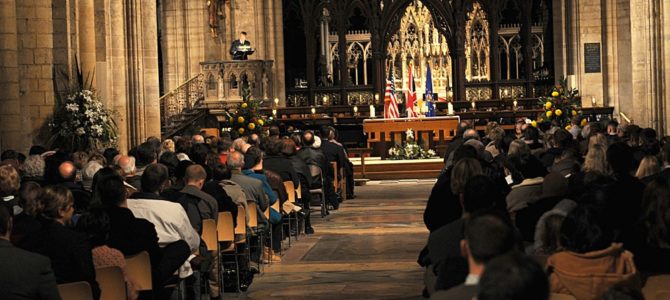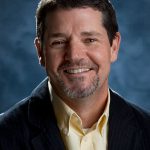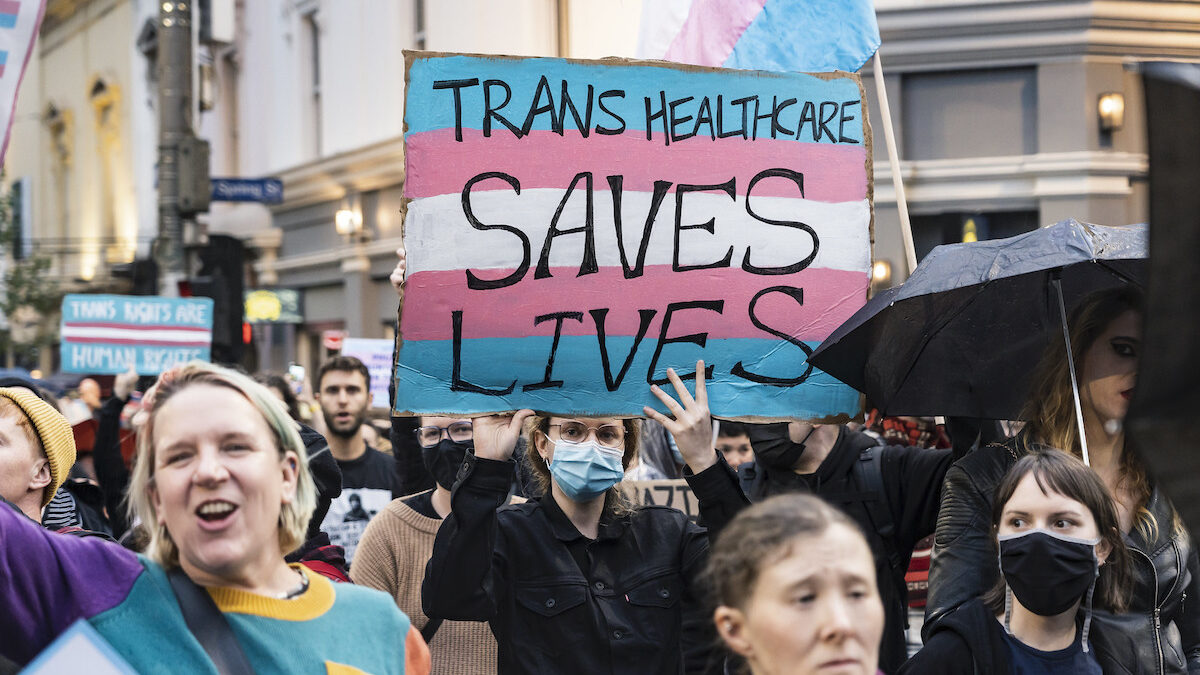
“Meanwhile, a widespread decline in churchgoing and religious affiliation had contributed to a growing anxiety among conservative believers.” Statements like this are uttered with such confidence and frequency that most Americans accept them as uncontested truisms. This one emerged just this month in an exceedingly silly article in The Atlantic on Vice President Mike Pence.
Religious faith in America is going the way of the Yellow Pages and travel maps, we keep hearing. It’s just a matter of time until Christianity’s total and happy extinction, chortle our cultural elites. Is this true? Is churchgoing and religious adherence really in “widespread decline” so much so that conservative believers should suffer “growing anxiety”?
Two words: Absolutely not.
New research published late last year by scholars at Harvard University and Indiana University Bloomington is just the latest to reveal the myth. This research questioned the “secularization thesis,” which holds that the United States is following most advanced industrial nations in the death of their once vibrant faith culture. Churches becoming mere landmarks, dance halls, boutique hotels, museums, and all that.
Not only did their examination find no support for this secularization in terms of actual practice and belief, the researchers proclaim that religion continues to enjoy “persistent and exceptional intensity” in America. These researchers hold our nation “remains an exceptional outlier and potential counter example to the secularization thesis.”
What Accounts for the Difference in Perceptions?
How can their findings appear so contrary to what we have been hearing from so many seemingly informed voices? It comes down primarily to what kind of faith one is talking about. Not the belief system itself, per se, but the intensity and seriousness with which people hold and practice that faith.
Mainline churches are tanking as if they have super-sized millstones around their necks. Yes, these churches are hemorrhaging members in startling numbers, but many of those folks are not leaving Christianity. They are simply going elsewhere. Because of this shifting, other very different kinds of churches are holding strong in crowds and have been for as long as such data has been collected. In some ways, they are even growing. This is what this new research has found.
The percentage of Americans who attend church more than once a week, pray daily, and accept the Bible as wholly reliable and deeply instructive to their lives has remained absolutely, steel-bar constant for the last 50 years or more, right up to today. These authors describe this continuity as “patently persistent.”
The percentage of such people is also not small. One in three Americans prays multiple times a day, while one in 15 do so in other countries on average. Attending services more than once a week continues to be twice as high among Americans compared to the next highest-attending industrial country, and three times higher than the average comparable nation.
One-third of Americans hold that the Bible is the actual word of God. Fewer than 10 percent believe so in similar countries. The United States “clearly stands out as exceptional,” and this exceptionalism has not been decreasing over time. In fact, these scholars determine that the percentages of Americans who are the most vibrant and serious in their faith is actually increasing a bit, “which is making the United States even more exceptional over time.”
This also means, of course, that those who take their faith seriously are becoming a markedly larger proportion of all religious people. In 1989, 39 percent of those who belonged to a religion held strong beliefs and practices. Today, these are 47 percent of all the religiously affiliated. This all has important implications for politics, indicating that the voting bloc of religious conservatives is not shrinking, but actually growing among the faithful. The declining influence of liberal believers at the polls has been demonstrated in many important elections recently.
These Are Not Isolated Findings
The findings of these scholars are not outliers. There has been a growing gulf between the faithful and the dabblers for quite some time, with the first group growing more numerous. Think about the church you attend, relative to its belief system. It is extremely likely that if your church teaches the Bible with seriousness, calls its people to real discipleship, and encourages daily intimacy with God, it has multiple services to handle the coming crowds.
Most decent-size American cities have a treasure trove of such churches for believers to choose from. This shows no sign of changing. If, however, your church is theologically liberal or merely lukewarm, it’s likely laying off staff and wondering how to pay this month’s light bill. People are navigating toward substantive Christianity.
The folks at Pew have been reporting for years that while the mainline churches are in drastic free fall, the group that “shows the most significant growth is the nondenominational family.” Of course, these nondenominational churches are 99.9 percent thorough-blooded evangelical. Pew also notes that “evangelical Protestantism and the historically black Protestant tradition have been more stable” over the years, with even a slight uptick in the last decade because many congregants leaving the mainline churches are migrating to evangelical churches that hold fast to the fundamentals of the Christian faith.
When the so-called “progressive” churches question the historicity of Jesus, deny the reality of sin, support abortion, ordain clergy in same-sex relationships and perform their marriages, people desiring real Christianity head elsewhere. Fact: evangelical churches gain five new congregants exiled from the liberal churches for every one they lose for any reason. They also do a better job of retaining believers from childhood to adulthood than do mainline churches.
The Other Key Factor: Faithful People Grow More Children
There is another factor at work here beyond orthodox belief. The University of London’s Eric Kaufmann explains in his important book “Shall the Religious Inherit the Earth?” (he says yes) that the sustaining vitality, and even significant per capita growth, of serious Christian belief is as firmly rooted in fertility as it is in faithful teaching and evangelism. Globally, he says that the more robust baby-making practices of orthodox Jews and Christians, as opposed to the baby-limiting practices of liberals, create many more seriously religious people than a secular agenda can keep up with.
Fertility determines who influences the future in many important ways. He puts it bluntly, “The secular West and East Asia are aging and their share of the world population declining. This means the world is getting more religious even as people in the rich world shed their faith.”
Fertility is as important as fidelity for Christianity and Judaism’s triumph from generation to generation. Kaufmann contends, “Put high fertility and [faith] retention rates together with general population decline and you have a potent formula for change.”
It comes down to this: God laughs at the social Darwinists. Their theory is absolutely true, but just not in the way they think. Those who have the babies and raise and educate them well tend to direct the future of humanity. Serious Christians are doing this. Those redefining the faith and reality itself are not.
This why Orthodox theologian David Bentley Hart proclaimed in First Things, long before the proposal of the Benedict Option, that the most “subversive and effective strategy we might undertake [to counter the culture] would be one of militant fecundity: abundant, relentless, exuberant, and defiant childbearing.” The future rests in the hands of the fertile.
What About All the Millennial Ex-Christians?
But what about our young people? We are constantly hearing that young people are “leaving the church in droves,” followed by wildly disturbing statistics. This also requires a closer look at who is actually leaving and from where. Pew reports that of young adults who left their faith, only 11 percent said they had a strong faith in childhood while 89 percent said they came from a home that had a very weak faith in belief and practice.
It’s not a news flash that kids don’t tend to hang onto what they never had in the first place. Leading sociologist of religion Christopher Smith has found through his work that most emerging adults “report little change in how religious they have been in the previous five years.” He surprisingly also found that those who do report a change say they have been more religious, not less. This certainly does not mean there is a major revival going on among young adults, but nor does it mean the sky is falling.
Add to this Rodney Stark’s warning that we should not confuse leaving the faith with attending less often. He and other scholars report that young adults begin to attend church less often in their “independent years” and have always done so for as long back as such data has been collected. It’s part of the nature of emerging adulthood. Just as sure as these young people do other things on Sunday morning, the leading sociologists of religion find they return to church when they get married, have children, and start to live a real adult life. It’s like clockwork and always has been. However, the increasing delay among young adults in entering marriage and family is likely lengthening this gap today.
More Americans Attend Church Now Than At the Founding
What is really counter-intuitive is what Stark and his colleagues at the Baylor Institute for Studies of Religion found when looking at U.S. church attendance numbers going back to the days of our nation’s founding. They found that the percentage of church-attending Americans relative to overall population is more than four times greater today than it was in 1776. The number of attendees has continued to rise each and every decade over our nation’s history right up until the present day.
People are making theological statements with their feet, shuffling to certain churches because they offer what people come seeking: clear, faithful, practical teaching of the scriptures, help in living intimately with and obediently to God, and making friends with people who will challenge and encourage them in their faith. To paraphrase the great Southern novelist Flannery O’Connor, if your church isn’t going to believe and practice actual Christianity, then “to hell with it.” This is what people are saying with their choices.
Or as Eric Kaufmann asserts, “Once secularism rears its head and fundamentalism responds with a clear alternative, moderate religion strikes many as redundant. Either you believe the stuff or you don’t. If you do, it makes sense to go for the real thing, which takes a firm stand against godlessness.”
If your Christianity is reconstituted to the day’s fashion, don’t be surprised if people lose interest in it. Few are seeking 2 Percent Christianity. They want the genuine deal, and the demographics on religion of the last few decades unmistakably support the fact.
This article was adapted from “The Myth of the Dying Church: How Christianity is Actually Thriving in America and the World.” It releases June 18, 2019; pre-orders available now.









